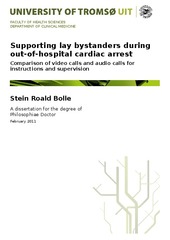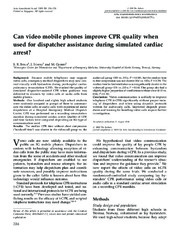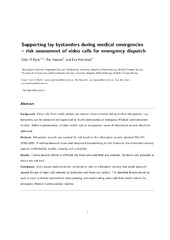| dc.contributor.advisor | Gilbert, Mads | |
| dc.contributor.advisor | Hjortdahl, Per | |
| dc.contributor.advisor | Braaten, Tonje | |
| dc.contributor.author | Bolle, Stein Roald | |
| dc.date.accessioned | 2011-09-14T08:02:33Z | |
| dc.date.available | 2011-09-14T08:02:33Z | |
| dc.date.issued | 2011-05-20 | |
| dc.description.abstract | Akuttmedisinske situasjoner krever rask, god og effektiv kommunikasjon. Publikum har i økende grad mulighet for videokonferanse via vanlige mobiltelefoner. Kan legfolk i fremtiden få bedre hjelp fra medisinsk nødnummer (113) hvis de kan vise levende bilder fra akuttmedisinske situasjoner via mobiltelefonen? Dette er hovedspørsmålet i dette doktorgradsarbeidet utført ved Nasjonalt senter for samhandling og telemedisin og Akuttmedisinsk klinikk ved Universitetssykehuset Nord-Norge. 180 elever fra videregående skoler i Tromsø deltok som legfolk ved simulerte hjertestans. Under forsøkene kommuniserte elevene med AMK-sykepleiere på medisinsk nødnummer (113). Kommunikasjonen skjedde ved hjelp av to typer mobiltelefoner: vanlige mobiler med kun tale, eller mobiler med både tale og toveis bildeoverføring (video). Tidsbruk og kvaliteten på gjennomført gjenoppliving ble målt på gjenopplivingsdukker i en randomisert kontrollert studie. Sykepleierne ble intervjuet og studentene besvarte et spørreskjema etter forsøkene. Et panel sammensatt av ulike fagprofesjoner utførte risikoanalyse av informasjonssikkerheten for videokonferanse via mobiltelefoner mellom legfolk og medisinsk nødnummer (113). Ifølge sykepleierne som deltok i forsøkene ga videokonferanse økt kvalitet på kommunikasjonen med legfolk, og enklere veiledning når de kunne se både «pasienten» og gjenopplivingsforsøkene. Sykepleierne mente derfor videokonferanse kan gi økt trygghet, spart tid og bedre behandling. Kvaliteten på videokonferansen var for dårlig i disse forsøkene til å gi tydelige forskjeller i gjennopplivingskvaliteten, men legfolk følte det tryggere å ha visuell kontakt med AMK-operatørene. Risikoanalyse av denne teknologien avdekket ikke uakseptable risiki mot informasjonssikkerheten. Nye mobiltelefoner med videotelefoni og bedre teknologi vil kunne gi bedre kvalitet på nødkommunikasjonen og gjenopplivning i akuttsitusjoner. Reelle hendelser må studeres for å finne hvordan billedkommunikasjon best kan utnyttes i akuttmedisinske situasjoner. | en |
| dc.description.abstract | Medical emergencies require rapid, effective and good communication. The public has increasing possibilities for video conferencing over regular cell phones. Can lay people in the future get better help from emergency medical dispatch centers if they can transmit live images from medical emergencies via cell phones? This is the main question in this doctoral thesis conducted at the Norwegian Centre for Integrated Care and Telemedicine and Division of Trauma Care and Pre-Hospital Services at the University Hospital of North Norway, Tromsø, Norway. One hundred eighty high schools students from Tromsø participated in simulated cardiac arrest. During the tests the students communicated with dispatcher nurses. The communication took place using two types of mobile phones: regular phones with just voice, or telephones with voice and two-way video transmission. A resuscitation manikin was used to measure duration and quality of resuscitation in a randomized controlled trial. After the effort, participants were interviewed or answered a questionnaire. A risk analysis was performed for the information security of video dispatch. According to the dispatchers, videoconferencing improved the quality of communication, and supervision became easier when they could see both the "patient" and resuscitation attempts. The dispatchers thought videoconferencing can provide increased confidence, time savings and better treatment. The quality of the video conference was not sufficient in these trials to provide clear differences in resuscitation quality, but lay people felt more safe when they had visual contact with the dispatchers. The risk analysis of this technology revealed no unacceptable risks to information security. Video enabled mobile phones and improved communication technology may provide better quality of communication and resuscitation in medical emergencies. Actual events must be studied to determine how visual communication best can be utilized in emergency medical situations. | en |
| dc.description.doctoraltype | ph.d. | en |
| dc.description | Papers number 1 and 2 of the thesis are not available in Munin: <br/>1. Johnsen E, Bolle SR.: 'TO SEE OR NOT TO SEE : Better dispatcher-assisted CPR with videocalls? A qualitative study based on simulated trials', Resuscitation (2008) Sep;78(3):320-6. Available at <a href=http://dx.doi.org/10.1016/j.resuscitation.2008.04.024>http://dx.doi.org/10.1016/j.resuscitation.2008.04.024</a> <br/>2. Bolle SR, Johnsen E, Gilbert M.: 'Video calls for dispatcher-assisted cardiopulmonary resuscitation can improve the confidence of lay rescuers - surveys after simulated cardiac arrest', Journal of Telemedicine and Telecare, March 2011, vol. 17 no. 2, p 88-92. Available at <a href=http://dx.doi.org/10.1258/jtt.2010.100605>http://dx.doi.org/10.1258/jtt.2010.100605</a> | en |
| dc.identifier.isbn | 978-82-7589-304-6 | |
| dc.identifier.uri | https://hdl.handle.net/10037/3597 | |
| dc.identifier.urn | URN:NBN:no-uit_munin_3313 | |
| dc.language.iso | eng | en |
| dc.publisher | Universitetet i Tromsø | en |
| dc.publisher | University of Tromsø | en |
| dc.rights.accessRights | openAccess | |
| dc.rights.holder | Copyright 2011 The Author(s) | |
| dc.rights.uri | https://creativecommons.org/licenses/by-nc-sa/3.0 | en_US |
| dc.rights | Attribution-NonCommercial-ShareAlike 3.0 Unported (CC BY-NC-SA 3.0) | en_US |
| dc.subject | HLR | en |
| dc.subject | hjerte-lunge-redning | en |
| dc.subject | gjenoppliving | en |
| dc.subject | førstehjelp | en |
| dc.subject | medisinsk nødtelefon | en |
| dc.subject | videokonferanse | en |
| dc.subject | CPR | en |
| dc.subject | bystander CPR | en |
| dc.subject | resuscitation | en |
| dc.subject | dispatcher assistance | en |
| dc.subject | videoconference | en |
| dc.subject | VDP::Medical disciplines: 700::Clinical medical disciplines: 750::Cardiology: 771 | en |
| dc.subject | VDP::Medisinske Fag: 700::Klinisk medisinske fag: 750::Kardiologi: 771 | en |
| dc.subject | VDP::Medical disciplines: 700::Clinical medical disciplines: 750::Traumatology: 783 | en |
| dc.subject | VDP::Medisinske Fag: 700::Klinisk medisinske fag: 750::Traumatologi: 783 | en |
| dc.subject | VDP::Medical disciplines: 700::Clinical medical disciplines: 750::Other clinical medical disciplines: 799 | en |
| dc.subject | VDP::Medisinske Fag: 700::Klinisk medisinske fag: 750::Andre klinisk medisinske fag: 799 | en |
| dc.subject | VDP::Technology: 500::Information and communication technology: 550::Telecommunication: 552 | en |
| dc.subject | VDP::Teknologi: 500::Informasjons- og kommunikasjonsteknologi: 550::Telekommunikasjon: 552 | en |
| dc.title | Supporting lay bystanders during out-of-hospital cardiac arrest : comparison of video calls and audio calls for instructions and supervision | en |
| dc.type | Doctoral thesis | en |
| dc.type | Doktorgradsavhandling | en |


 English
English norsk
norsk






